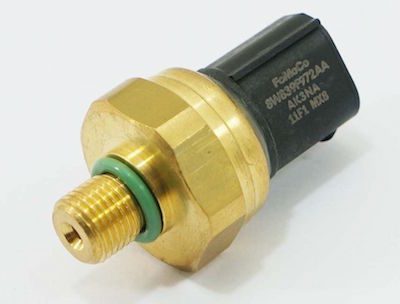
P0193 Fuel Rail Pressure Sensor “A” High
Content
- OBD-II Trouble Code - P0193 - Technical Description
- What does trouble code P0193 mean?
- Symptoms
- Causes of the P0193 code
- Diagnostic and repair procedures
- How does a mechanic diagnose a P0193 code?
- Common Mistakes When Diagnosing Code P0193
- How serious is the P0193 code?
- What repairs can fix code P0193?
- Additional comments to consider regarding code P0193
- Need more help with your p0193 code?
OBD-II Trouble Code - P0193 - Technical Description
Fuel rail pressure sensor "A" high.
P0193 is a Diagnostic Trouble Code (DTC) Fuel Rail Pressure Sensor Circuit High Input. This can happen for several reasons and it is up to the mechanic to diagnose the specific cause of this code being triggered in your situation.
What does trouble code P0193 mean?
This Generic Transmission / Engine DTC usually applies to most fuel injection engines, both gasoline and diesel, since 2000. The code applies to all manufacturers such as Volvo, Ford, GMC, VW, etc.
This code strictly makes sure that the input signal from the fuel rail pressure sensor stays above the calibrated limit for the calibrated amount of time. This could be a mechanical failure or an electrical failure, depending on the vehicle manufacturer, fuel type and fuel system.
Troubleshooting steps may vary depending on the manufacturer, type of rail pressure system, type of rail pressure sensor, and wire colors.
Symptoms
Symptoms of a P0193 engine code may include:
- Malfunction Indicator Lamp (MIL) illuminated
- Lack of power
- Engine starts but won't start
Causes of the P0193 code
Possible reasons for setting this code:
- Short circuit of FRP signal to PWR
- FRP signal open circuit
- Damaged FRP sensor
- Little or no fuel
- Exposed, broken, shorted, or corroded wiring
- Corroded connectors
- Clogged fuel filter
- Faulty fuel pump relay
- Bad fuel rail sensor
- Defective fuel pump
Diagnostic and repair procedures
A good starting point is always to check the Technical Service Bulletins (TSB) for your particular vehicle. Your problem may be a known issue with a known manufacturer-released fix and could save you time and money while troubleshooting.
Then find the fuel rail pressure sensor on your specific vehicle. It might look something like this:

Once detected, visually inspect the connectors and wiring. Look for scuffs, scuffs, exposed wires, burn marks, or molten plastic. Disconnect the connectors and carefully inspect the terminals (metal parts) inside the connectors. See if they look rusty, burnt, or perhaps green compared to the usual metallic color you're probably used to seeing. If terminal cleaning is required, you can purchase electrical contact cleaner at any parts store. If this is not possible, find 91% rubbing alcohol and a light plastic bristle brush to clean them. Then let them air dry, take a dielectric silicone compound (the same material they use for bulb holders and spark plug wires) and place where the terminals make contact.
Then check that the vacuum hose connecting the sensor to the intake manifold is not leaking (if used). Inspect all vacuum hose connections at the rail pressure sensor and intake manifold. Note if fuel is coming out of the vacuum hose. If so, the fuel rail pressure sensor is faulty. Replace if necessary.
If you have a scan tool, clear the diagnostic trouble codes from memory and see if the code returns. If this is not the case, then there is most likely a connection problem.
If the code comes back, we will need to test the sensor and its associated circuits. There are usually 3 wires connected to the FRP sensor. Disconnect the wiring harness from the FRP sensor. For this code, the easiest way is to make a fuse jumper (it's a fuse jumper on the line; it protects the circuit you're testing) and connect the SIG RTN wire to the FRP signal input wire. With the scan tool connected, monitor the FRP sensor voltage. Now it should show close to zero volts. If a scan tool with data stream is not available, check if P0192 FRP Sensor Circuit Input Low is set. If any of this happened, then the wiring and PCM are in order. The most likely problem is the sensor itself.
If all tests have passed so far and you keep getting the P0193 code, it most likely indicates a faulty FRP sensor, although the failed PCM cannot be ruled out until the sensor is replaced.
ATTENTION! On diesel engines with common rail fuel systems: if a fuel rail pressure sensor is suspected, you can have a professional install the sensor for you. This sensor may be installed separately or may be part of the fuel rail. In any case, the fuel rail pressure of these diesel engines at warm idle is typically at least 2000 psi, and under load can be well over 35,000 psi. If not properly sealed, this fuel pressure can cut the skin, and diesel fuel has bacteria in it that can cause blood poisoning.
How does a mechanic diagnose a P0193 code?
- The mechanic will begin by inspecting the wiring and connectors for melted wires, broken wires, and corrosion. Repair of electrical wiring and connections if necessary.
- They will use an OBD-II scanner to retrieve freeze frame data and trouble codes stored in the power management module.
- They will complete a test drive after clearing the codes to see if DTC P0193 returns.
- If DTC P0193 does not return immediately, this indicates the possibility of an intermittent problem. Intermittent problems may need to worsen before a correct diagnosis can be made.
- If the car does not start, there is a chance that there is no fuel in the fuel tank. Use a pressure gauge to check fuel pressure. Low fuel pressure is a sign that there is little or no fuel in the vehicle.
- To make sure the fuel pump is working properly, the mechanic will listen to it. If the car won't start but you still hear the sound of the fuel pump, the fuel injector circuit may be faulty or the fuel filter may be clogged.
- If the car won't start and they can't hear the fuel pump running, they will try to start the car while another person is pounding on the bottom of the fuel tank. If the car starts, it means that the fuel pump needs to be replaced.
- If the car won't start, they check the battery voltage at the fuel pump connector. If there is no battery voltage at the fuel pump connector, they will check the fuse circuit, the fuel pump relay circuit, and the power control module circuit for faults.
- If these components are OK, check the fuel rail pressure sensor. Check the fuel rail pressure sensor reference voltage with a digital volt/ohmmeter while the vehicle is moving. The voltage reading should be 5 volts. If this test is successful, check the ground wire.
- If there is both a reference signal and a ground signal, check the resistance of the sensor. If the sensor resistance test results are not within manufacturer's specifications, the fuel rail pressure sensor needs to be replaced.
- If the circuit and sensors are working properly, there is a chance that the power management module is faulty. This is rare, but will require replacement and reprogramming.
Common Mistakes When Diagnosing Code P0193
The most common mistake when diagnosing a P0193 DTC is neglecting to first check the fuel level to make sure the car has gas in it. No gas or low gas levels often cause the power control module to store this DTC. This should be one of the first things checked in addition to other fuel system components before replacing the fuel rail pressure sensor.
How serious is the P0193 code?
DTC P0193 should be diagnosed and repaired immediately. This code is considered serious because it can cause drivability issues such as failure or starting problems, making driving difficult as well as dangerous.
What repairs can fix code P0193?
- Add fuel to the fuel tank
- Repair broken or shorted wires
- Repair corrosion of wiring and/or connectors
- Replace clogged fuel filter
- Replace fuel pump relay
- Replace fuel pump fuse
- Replace fuel pump
- Replace fuel rail pressure sensor
Additional comments to consider regarding code P0193
Before replacing the fuel pump or other fuel system components, make sure that the car is not just out of gas. It is also important to complete all diagnostic steps before replacing the fuel rail pressure sensor.
Need more help with your p0193 code?
If you still need help with DTC P0193, post a question in the comments below this article.
NOTE. This information is provided for informational purposes only. It is not intended to be used as a repair recommendation and we are not responsible for any action you take on any vehicle. All information on this site is protected by copyright.

5 comments
Silverware
Hello I have a Peugeot 307 hatbach year 2007 1,6hdi 90hp and I get the codes p0193 positive pressure fuel signal short to positive or open circuit code p1351 Controlled pre / post heating circuit and spark plugs are not provided thank you
Jc
Hello df p0193 toothed wheel esque it can come from the fuse it no longer fits in its housing thank you
antonio morals
Hi everyone, I have a volvo s80 v8 with the same symptom as code p0193, the check engine light always comes on
Damian
Hello. I have a problem with Peugeot 307 1.6hdi. P0193 error occurs. The diagnostics indicate the fuel pressure on the CR rail is over 33400 kPa. After replacing the sensor, the pressure remained at the same level, the harness from the sensor to the controller was checked, the continuity of the wires was OK, there were no short circuits between the wires or to ground, even with the plug from the pressure sensor on the CR rail disconnected, the fuel pressure was the same. Maybe someone has an idea for this car?
Damiano
Hello. I have a problem with Peugeot 307 1.6hdi. P0193 error occurs. The diagnostics indicate the fuel pressure on the CR rail is over 33400 kPa. After replacing the sensor, the pressure remained at the same level, the harness from the sensor to the controller was checked, the continuity of the wires was OK, there were no short circuits between the wires or to ground, even with the plug from the pressure sensor on the CR rail disconnected, the fuel pressure was the same. Maybe someone has an idea for this car